Yoga at its deepest core and oldest pillars is about connection. Yoga connects you with the natural world, the spiritual, and yourself. All of which come together for a holistic experience.
Practitioners can connect with nature through yoga through breathing and grounding techniques. Yogis can also embody the history of connection with nature by observing and imitating elements found in the environment.
As a bonus, they may take their sessions outdoors for direct connection.
Here are some of the ways we connect with nature through yoga. We’ll go from what we mean by connection and then into the individual aspects.
Connecting
Nature is a unified whole, and yoga works the same way. Yoga focuses on the mind, body, and spirituality to bring them into one experience, one soul.
More than that, on a scientific level, we are made of the same matter that cycled through time and space. The famous astrophysicist and science communicator, Carl Sagan, has said, “We’re made of star-stuff. We are a way for the cosmos to know itself.”
Sometimes we forget that being human is part of being part of nature. Our well-being depends on us understanding our own nature whether it’s delight, anxiety, hunger, sleepiness, or physical distress.
When we learn how to connect through yoga, we’re as much connecting and balancing rhythms with ourselves as the world around us. It’s all nature.
Breathing
One of the most fundamental yoga principles is deep breathing. Like themes in nature, our breath is steady and a recurring cycle. Meditative breathing emphasizes an even, long, deep breath that we regulate consciously.
Often, we’re not conscientious of nature’s cycles. The techniques used with breathing ask us to visualize natural patterns like seasons and water flow. Breathing is associated with life itself, and thus it’s a symbol of our connection with nature.
Even if you can’t make it to a class, outside, or have a reason for not doing poses, you can still connect with nature through breathing. Sit by a window and practice breathing while bringing in the sights, sounds, and maybe even air of your backyard.
Grounding
In yoga, we have grounding or earthing. We seek to connect through the earth with an even breath and weight distribution. We strive for this connection indoors or out.
Yoga also has us using our bare hands and feet. This approach is one of many to establish a purer connection with the earth. It’s the equivalent of deep breathing exercises for the sense of touch. Touch also most engages our nervous system with the world.
Grounding also has to do with chakras. When we feel anxious, engaging with grounding and appreciating the earth outside calms us and that chakra.
Observing Nature
Yoga teaches you to observe your body and the moment around you. Feel the breeze, hear your breath. If you practice outside, you can also meditate on more of nature.
You might listen to a deer grazing nearby. Or you may study the trees casting shadows. Yet, you may prefer to watch the clouds slowly hovering overhead. Observing the sky, in particular, gives you a sense of transcending your mundane reality.
Observing the sun safely, such as spending time outside in the middle of the day, stimulates your nervous system. Light bouncing into your pupils tells your system to be in a more energetic mode.
Imitating Nature
Beyond observing nature, early yoga practitioners created poses inspired by nature. Yogis imitate the rising sun in the popular session opener, sun salutation.
Another well-known pose for beginners is the tree pose. Some other poses are named after animals and their iconic movements.
An added benefit of using yoga to imitate nature is that you can still connect indoors. Breathing and grounding do this, but they represent the air, cycles, and the ground. Many poses were inspired by creatures to touch a deeper meaning of life.
Being in Nature
Taking the connection with nature one step further, you can do your practice outside. This approach unifies environmental, physical body, and spiritual nature.
Once outside, breathing takes a new significance. You take in new smells, temperature ranges, and sounds. These aspects make the experience distinct and help you stay in the moment.
One day you might have the cozy heat of the direct sun, vitamin D, and the singing of birds. Another day you may have crisp air, energizing wind, and smell soil bacteria that release the well-known “rainy” smell in a storm.
If you have a suitable location, you can practice directly on the earth. You can feel the dewy grass or powdery soil on your bare hands and feet. Many outdoor enthusiasts don’t get to do that. They always have equipment between them and nature.
